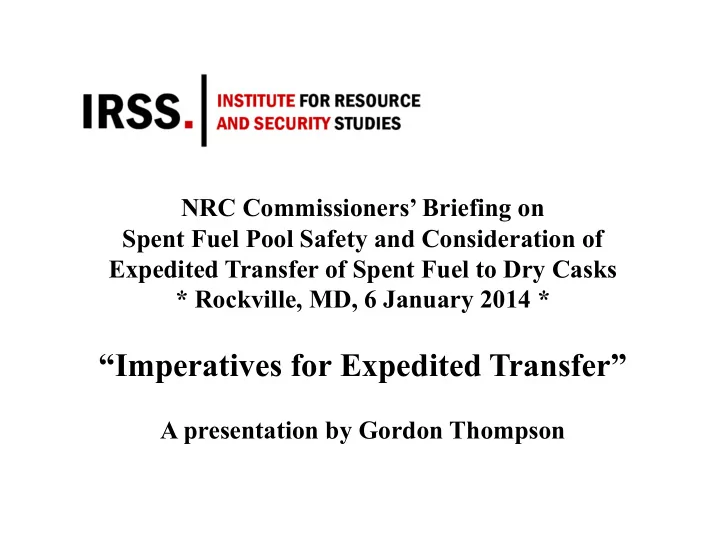

NRC Commissioners’ Briefing on Spent Fuel Pool Safety and Consideration of Expedited Transfer of Spent Fuel to Dry Casks * Rockville, MD, 6 January 2014 * “Imperatives for Expedited Transfer” A presentation by Gordon Thompson
Low-Density, Open-Frame Rack for Storing Spent Fuel (PWR) • Criticality is suppressed by geometry • If water is lost, fuel will be cooled by 3-D convective circulation of air and steam • Spent fuel is passively protected against zirc. self- ignition across a broad range of water-loss scenarios
Modes of Water Loss from a Spent-Fuel Pool Mode of Water Relevant to Relevant to Loss Accidents? Attacks? Sloshing Yes* Yes Displacement Yes Yes Tipping of pool Yes Yes Siphoning or No Yes Pumping Boiling Yes Yes Leakage Yes* Yes * Modes considered by NRC Staff, but only for earthquake initiation
“Severe Reference” Case for Water Loss • This case represents many water-loss scenarios • Could proceed to zirc.-steam ignition • Paks-2 accident in 2003 provides a partial analog • NRC refuses to study this case Figure from: Braun, 2010.
Ignition Delay Time in Severe Reference Case (PWR fuel) Fuel Age Ignition Delay Time 10 days 1.4 hours 100 days 3.9 hours 1,000 days 21 hours Notes: (a) Here, ignition delay time (IDT) = time required for decay heat to raise fuel temp. from 100°C to 1,000°C under adiabatic conditions, for a fuel burnup of 50 GWt-days per Mg U. (b) IDT is 30% higher for BWR fuel (with channel boxes).
Onsite Radiation Field Created by a Reactor Release: An Illustrative Case Indicator Av. Over 1 Day Av. Over 7 Days Dose rate 44 Sv/hr 18 Sv/hr Time to accrue 4 minutes 10 minutes median lethal dose (3 Sv) Notes: (a) This case assumes uniform distribution, across a circle of 200 m radius, of 10% of I and Cs, and 5% of Te, in the core of a 2910 MWt reactor. (b) Radiation dose is whole-body groundshine without shielding. (c) Calculations are in a Nov. 2000 report by Gordon Thompson.
Some Outcomes Associated with Atmospheric Release of Cs-137 Actual Releases • Chernobyl (85 PBq): “Perhaps the real cause of the collapse of the Soviet Union” (Gorbachev, 2006) • Fukushima (36 PBq released; 6 PBq fallout on Japan): Displacement of 160,000 people; all nuclear power plants in Japan currently shut down Potential Releases • Peach Bottom (330 PBq): Long-term displacement of 4.1 million people (NRC average case) • Dampierre (100 PBq): Economic damage of $0.4 trillion to $8.1 trillion; “an unmanageable European catastrophe” (IRSN studies)
Some Inventories of Cs-137 Peach Bottom Pool: 2,200 PBq (One of two neighboring pools) Fukushima #1 Unit 4 Pool: 1,100 PBq Fukushima #1 Unit 3 Reactor: 350 PBq Dry Cask (32 PWR assemblies): 67 PBq Fukushima Fallout on Japan: 6 PBq
Some Observations About Radiological Risk • The statement: “risk = (probability)x(consequences)” is ideology, NOT science • If consequences could be severe, an appropriate indicator of probability would be the number of occurrences per century across all US facilities • Qualitative factors could be major determinants of probability and consequences • NRC’s consideration of pool fires has focused on rapid, total loss of water; this is a reprise of a 1960s focus on large-break LOCAs, which warped reactor design
A Wake-Up Call: Fukushima #1 Unit 4
Some Observations About Reverting to Low-Density, Open-Frame Racks • The major driver of cost would be the transfer of excess spent fuel to dry casks • This transfer will occur anyway, after reactors are shut down • Thus, the incremental cost of acting now is simply the time value of the transfer cost • Presence of high-burnup fuel could increase transfer cost; this is symptomatic of larger problems with high-burnup fuel
Conclusions • NRC should order the rapid reversion of all pools to low-density, open-frame racks • NRC should scrap the Staff’s pool-fire study and Tier 3 analysis • NRC should sponsor a thorough, open, science-based inquiry into phenomena related to pool (and cask) fires, including pool-reactor risk linkages • NRC should seek to internationalize the inquiry, in view of pool hazards elsewhere (e.g., La Hague)
Recommend
More recommend